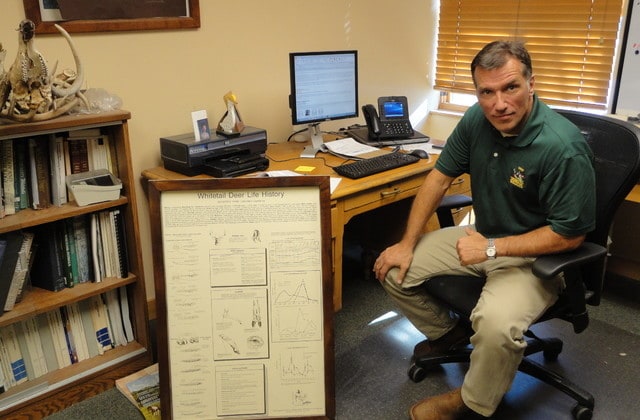
Tonkovich manages Ohio’s deer herd
By Jane Beathard

ATHENS, Ohio — From a tiny office in the Ohio Department of Natural Resource’s Athens office, wildlife biologist Mike Tonkovich crunches piles of data in support of an $853 million Ohio industry — deer hunting.
As the agency’s deer program administrator, it’s Tonkovich’s job to keep tabs on hundreds of thousands of whitetails scattered across all 88 counties. He monitors their numbers, location and overall condition.
In the language of wildlife conservation, Tonkovich and fellow ODNR biologist Clint McCoy “manage” the state’s deer herd.
It’s no easy job.
Using county-by-county “bag” or kill limits and permits to take antlerless deer, they strive to balance the needs of Ohio’s 75,000 farmers with the desires of its 350,000 licensed hunters — 85 percent of whom pursue deer in the fall and winter.
Those needs and desires are generally at odds, with farmers wanting no deer munching their row crops and hunters hoping to sight a deer behind every tree.
“I aspire to have equal numbers of hunters and farmers disliking me,” Tonkovich said, only half joking.
The biologists must also weigh the fervor of wildlife enthusiasts against the disdain of insurance industry executives who pay out millions of dollars annually in claims for deer-vehicle crashes.
“We need to know how many deer people want (or will tolerate) on the landscape,” Tonkovich said. “The challenge is getting to that number and maintaining it.”
He shys away from setting an estimate on the total number of whitetails in Ohio, saying it is irrelevant.
One thing is certain: There are more in Ohio now than a century ago.
According to the national Quality Deer Management Association, deer were abundant in the state until about 1870. After that, farming and the clearing of southern and eastern forests decimated deer habitat, making survival virtually impossible.
Scioto County reported its last deer killed in 1895, and the species was labeled extirpated, or destroyed, throughout the state in 1904.
A turnaround began in 1919 when nine does and one buck were imported and penned at Roosevelt Game Preserve in Scioto County. Over the next 12 years, state conservationists added to that number by obtaining deer from Illinois, Pennsylvania and private sources for the preserve.
At the same time, state officials worked to reforest southern and eastern Ohio in order to salvage the timber industry and create wildlife-friendly habitat.
In 1932, fences at the Roosevelt facility were purposely removed, releasing a reproductive herd of 1,000 whitetails into surrounding woodlands. Less-public restockings took place elsewhere around Ohio.
Nature took its course thanks to good genetics and plentiful food sources. By 1943, the state was ready for limited hunting in Pike, Adams and Scioto counties.
That year, hunters harvested 168 deer. Only one hunter in 50 met with success. In 2014-15, hunters took 191,459 deer. One in three was successful, Tonkovich noted.
But reintroduction success brought different problems, and biologists now fret about the future of Ohio’s deer herd.
“Overall quality is lower than it used to be,” he said.
He attributes the decline to many factors, including aging forests in southern counties and older, fewer big bucks statewide.
Eventually, these factors may impact the bottom lines of local outfitters, restaurants, hotels, gas stations, butcher shops and campgrounds that serve hunters. Many are off the beaten path and pin their profits to dollars generated between September and February when hunters are afield.
It comes down to a matter of quality verses quantity: more deer verses fewer, bigger deer, Tonkovich believes.
In December, the ODNR dispatched surveys to 19,000 hunters to see which they prefer.
That means Tonkovich and McCoy will soon have more numbers to crunch.
“Our busiest time of year is between December and February,” Tonkovich said. “That’s when the data comes in and everyone wants to know the results.”
QUICK FACTS:
• Deer are Ohio’s only big-game animals.
• The statewide economic impact of deer hunting is $853 million.
• There were about 275,000 resident deer hunters in 2014, the fifth-highest number in the nation.
• The number of out-of-state hunters who traveled to Ohio in 2014 was about 37,000.
• The number of statewide deer-vehicle crashes in 2014 was 19,705, including four fatalities.
• The average insurance claim of a deer-vehicle crash was $4,000 in 2014.
• The first modern deer hunt was in 1943 in Scioto, Adams and Pike counties.
• The first statewide deer hunt was in 1956.
• The number of deer harvested in the 2014-15 season was 191,459.
* From the ODNR and Ohio Insurance Institute.
ID, 'source', true); $sourcelink = get_post_meta($post->ID, 'sourcelink', true); $sourcestring = '' . __('SOURCE','gabfire') . ''; if ($sourcelink != '') { echo "
$sourcestring: $source
"; } elseif ($source != '') { echo "$sourcestring: $source
"; } // Display pagination $args = array( 'before' => '' . __('Pages:','gabfire'), 'after' => '
', 'link_before' => '', 'link_after' => '', 'next_or_number' => 'number', 'nextpagelink' => __('Next page', 'gabfire'), 'previouspagelink' => __('Previous page', 'gabfire'), 'pagelink' => '%', 'echo' => 1 ); wp_link_pages($args); // Display edit post link to site admin edit_post_link(__('Edit','gabfire'),'','
'); // Post Widget gab_dynamic_sidebar('PostWidget'); ?>